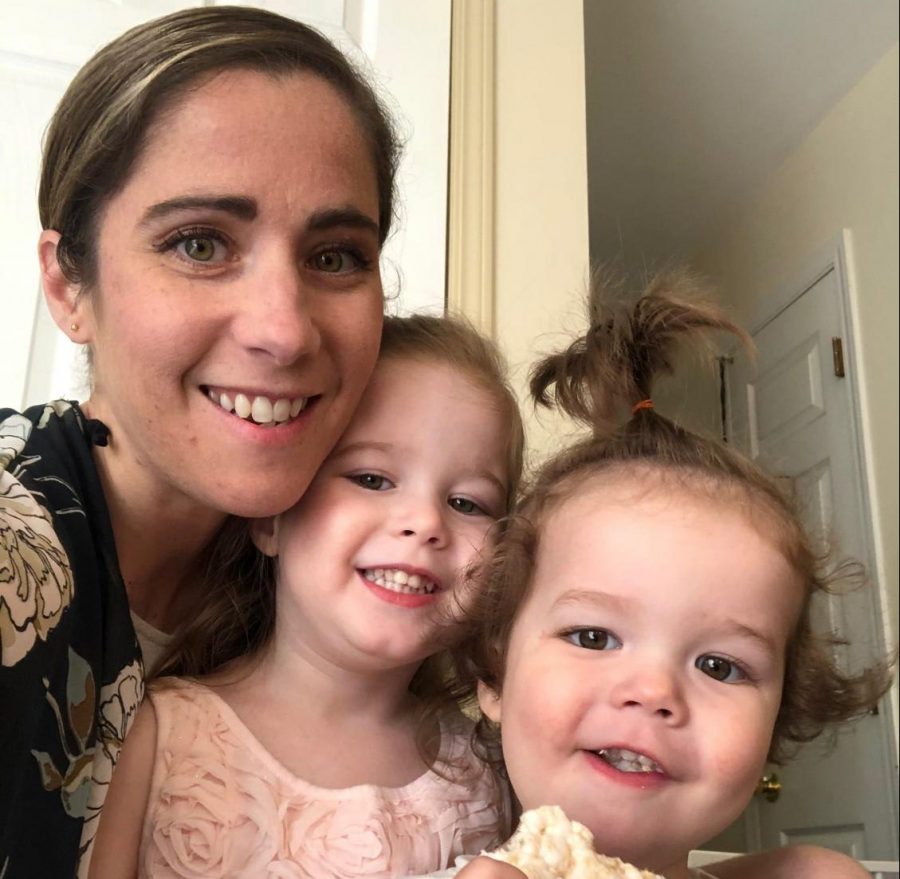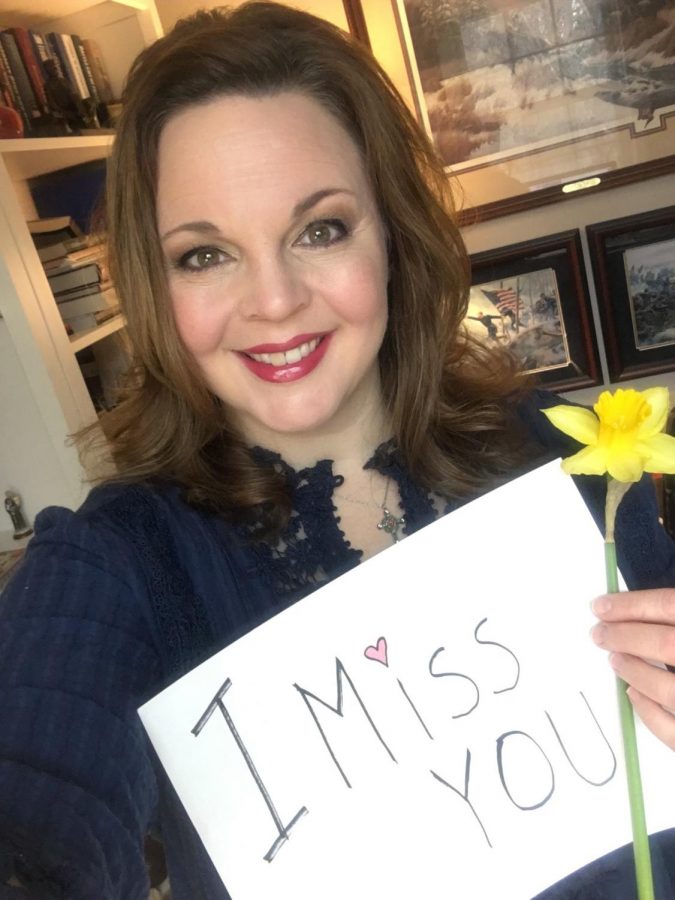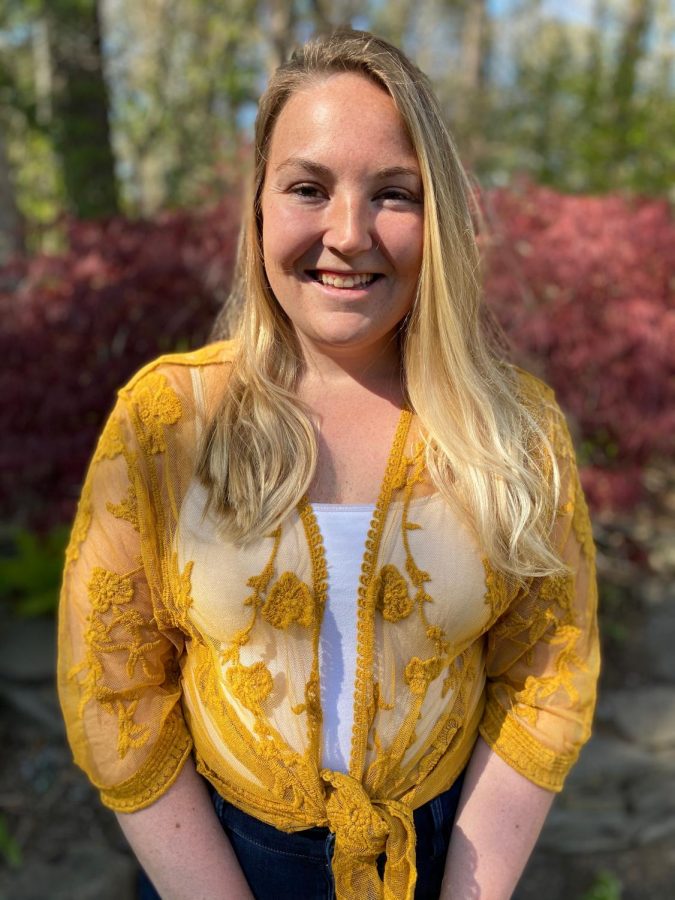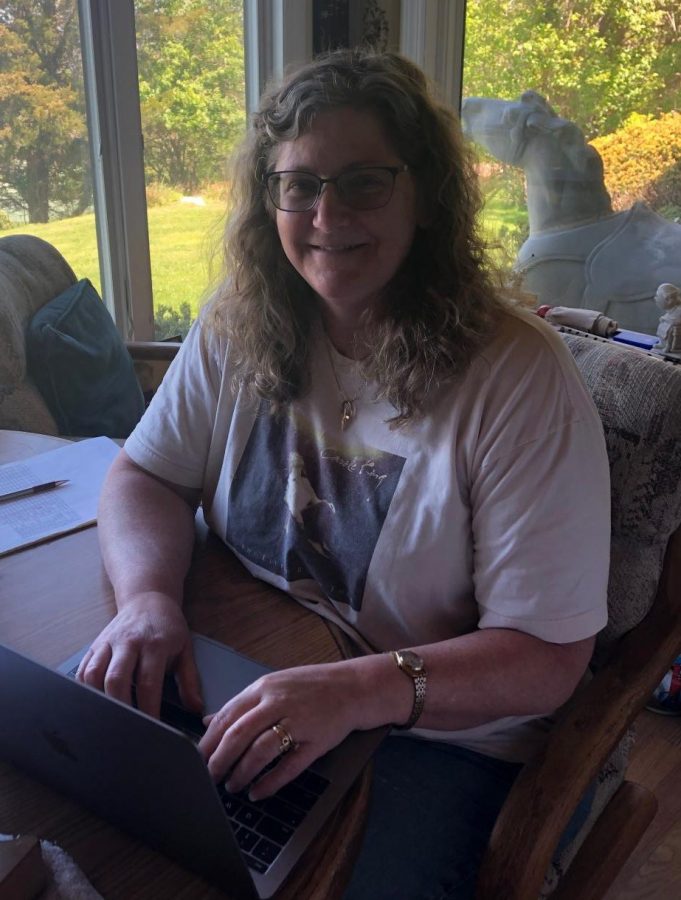Photograph provided by Meredith Barron.
Meredith Barron and her two daughters.
SWR Teachers Discuss Adapting to Distance Learning
Meredith Barron
May 13, 2020
“I wish we were in school.” That is what all teachers who love their jobs are probably saying right now. The Coronavirus has taken away their ability to teach their students in person, seeing them five days a week. Instead, students do their schoolwork online.
Spanish teacher Mrs. Meredith Barron misses being able to speak to students in person. She said that online learning doesn’t feel the same as communicating with her students directly.
“Face to face interaction is what I really miss the most,” Mrs. Barron said.
One plus in her distance learning experience is the opportunity to learn new programs to make learning easier. “I’ve gotten to learn how to use a lot of technology that I probably wouldn’t have learned,” she said.
In years past, Mrs. Barron used Google Classroom only for projects, and now she’s using it for all assignments. She is also discovering new programs like Screencastify, which she had her Spanish 5 students use for a project. Screencastify is a program where people present material through slides while their recorded voice plays in the background. Mrs. Barron is hoping that as distance learning goes on, she becomes more familiar with designing assignments on new programs to make learning a better experience for her students.
One flaw to distance learning that Mrs. Barron sees is the lack of interaction on a personal-speaking level, which she said is key to teaching a language. “It’s more difficult to teach a language online,” she said, explaining that it’s easier to learn a language if you can hear it in person to learn how to speak it fluently.
“I feel like trying to teach a language through the computer is definitely challenging. Learning Spanish involves hearing the language and talking in the language, and it’s not as easy to facilitate through computers. I’m missing that listening and speaking part,” Mrs. Barron said.
Most teachers at SWR have children, so online learning is an extra challenge, especially if they are young. Mrs. Barron and her husband are both teachers, and their two children are under the age of five. They have a set schedule — one parent watches them while the other teaches. Mrs. Barron’s husband is able to schedule his classes for different times than her classes. Mr. Barron’s school, unlike SWR, does not have 20 minute periods. Every hour, they rotate who is keeping an eye on the kids, and they have a designated room to do their online schooling.
“We switch on and off throughout the day. It’s working out, but in the beginning it was a little chaotic,” Mrs. Barron said, noting the children have been “pretty cooperative” as they have a good time with their mom or dad. But they can be too loud, and when this happens, whoever is teaching will send a text to ask them to quiet down.
“Sometimes he’ll be teaching live through Google Meet, and my kids will be belting out Frozen and laughing,” Mrs. Barron said.
Most teachers feel that online learning comes with more complications. For Mrs. Barron, online schooling is not more work, it’s having to get used to teaching in a different way– learning new technologies, figuring out how to grade assignments, and getting used to a new routine.
The grading system is another aspect teachers had to get used to. “It’s difficult to assess students right now. Grades shouldn’t be the focus of the learning that’s going on, and it’s difficult to make sure that everyone has access to the technology. Everyone’s situation is different. I feel like we have to have a grading system that is lenient.” Mrs. Barron said. She said the 0 through 4 system helps students think about what they could have done better if they got a 3 rather than a 4 on an assignment, and gives them more information on how they’re doing than a pass/fail system would.
What Mrs. Barron misses the most about school is talking to her students about how their lives are going. She misses saying “hola” as they enter her room and all the conversations that went on–from her teaching, to people asking questions, to getting side tracked in class, and to all the laughs.
Edward Storck
After schools were shut down due to the Coronavirus pandemic, students faced many changes in their daily routines and schooling. Teachers’ lives were also altered, and Mr. Edward Storck, English and AP Capstone teacher, faced many changes due to the shutdown.
“Personally, I’m extremely bored,” he said. “I miss human interaction, I miss seeing my students, and I miss our laughs.”
Mr. Storck said he needs a routine and right away established a new schedule for himself. “Every day when I wake up, I read a little bit, eat breakfast, and get everything together for school.”
For some teachers, it has been difficult to convert their classroom to a virtual setting. Mr. Storck, however, is very familiar with the technology being used and has helped many teachers learn to use it as well.
“I feel fortunate that I have been very tech-savvy over the years with AP Capstone. Before this pandemic hit, a lot of the stuff we had been doing was already digital, so the transition wasn’t too much of a challenge for me,” he said.
A difficult component of online learning has been the lack of social interaction. To combat this, Mr. Storck found a way to incorporate some interaction into his classes.
“Every Monday, we host live lessons during my class periods, and the kids have seemed to really enjoy that time to connect and learn from each other,” he said.
Although the students are doing the best they can, Mr. Storck said he reaches out to students who are struggling and reminds them of the flexibility of this completely new school environment.
“Whatever people thought they knew about school, throw it out the window,” he said. “We now have a different school, where we’re all going to be more patient with one another. We’re going to reach out and support one another and make the best of this situation.”
After school, Mr. Storck’s favorite activity is going outside and jogging. He said he lives in an apartment complex, and since he does not have a backyard, it gets overwhelming to be inside.
“Sometimes I want to break free, and jogging has given me a reason to go outside,” he said. “I’ve been pretty consistent, and I think I’m enjoying it because it’s been such a challenge for me personally, but I’m seeing my time get better, and I’m seeing myself get faster.”
In addition, Mr. Storck spends his time watching Netflix and staying updated on the news. He has also added meditation into his daily routine.
“I’ve been meditating for 15 minutes a day for the past two weeks, and it has become a great thing for me,” he said.
Jennifer Zito
As quarantine drags on, SWR physics teacher Mrs. Jennifer Zito spends time with her five children, her husband, and her dog and cat. She is either cooking for the whole family or distance teaching, so it sometimes gets a little crazy.
“I wouldn’t have it any other way,” Mrs. Zito said. She tries to keep sane with Kempo classes, which she participates in over Zoom.
When she’s online for school, Mrs. Zito slows down her lesson plans so her students can complete assigned reading. With the Regents exam cancelled, she said she can slow down the speed of introducing material.
“There would have been a good deal of time we would have spent reviewing for the Regents at the end of the year, so I’m more than happy to slow down so the students can leave with all the Regents curriculum under their belts,” Mrs. Zito said. She added that she is happy with the way SWR is handling distance learning.
Like many other teachers, Mrs. Zito works all day and sometimes into the night. She tries to give each student unique, individual feedback on their work so they have a secure understanding as to what is going on.
“I hope my students are comfortable enough with me to say they don’t understand something, or if I’m asking too much of them,” she said.
Ruth Squillace
With the unprecedented COVID-19 pandemic, the future is unknown. Schools around the world have turned to online learning as their only hope to continue with their students’ education.
For Mrs. Ruth Squillace, who teaches Criminal Justice and Participation in Government/Economics, there are many negatives about online learning. In school, Mrs. Squillace enjoys seeing her students and talking to them. She is able to actually see their facial expressions, which can tell her if a student is having a bad day and allows her to comfort them and communicate. In the classroom, Mrs. Squillace can recognize if the students are understanding the material just by their facial expressions, and when she sees confusion, she can step back and teach in a way that makes more sense to them. “I can’t read my students through a screen,” she said. There is a lack of communication verbally or visually. “In distance learning, there is distance,” she said.
Mrs. Squillace also said she has lost a friend and has numerous friends on life support due to COVID-19.
Mrs. Squillace has some concerns for the rest of the year. “My main concern is the wellbeing of my students, the rest will work itself out.” In her classes, she tries to give the same work that she would if her students were in class, especially in her Participation in Government/Economics class because the students “learn through the lens of current events.”
Mrs. Squillace said she misses her students, colleagues, interactions and working on her feet. However, using technology as a means of education will help her with future online assignments because she is more comfortable with it. She said that her colleagues have been outstanding, and Mr. Ed Storck and Mrs. Sara Trenn have offered their time to help teachers learn more about how to incorporate different types of programs in their lessons.
For Mrs. Squillace, online learning has “confirmed providing a lot of direction and a lot of support” is how students learn best.
Maryanne Agius
Though COVID-19 has been difficult for students, teachers are also finding this time to be challenging.
“Personally, it’s been really challenging because I, as a teacher, am really interactive and creative, and I feel like I am in a cage right now, so it has been an emotional journey, I suppose,” Ms. Maryanne Agius, an SWR Spanish teacher, said.
Given the unfortunate circumstances, Ms. Agius has been attempting to make the adjustment of quarantine easier and productive. She said she started limiting her screen time once she noticed that it was 11 hours per day when schools had first closed.
In addition, Ms. Agius led a project made by the SWR staff. Along with others, she created a video that included many staff members holding up signs with positive messages directed at students. Ms. Agius said that this idea was inspired by others.
“It was a decision made by a bunch of teachers on the staff advisory council. We saw that other schools, along with one of our elementary schools, did it, so we wanted to make one ourselves.” The intention of the video was to bring hope and positivity to the students, and SWR students actually responded to the video by creating one for the teachers.
Ms. Agius has also involved herself with healthy distractions when she is not grading her students work or constructing lessons for online classes by partaking in pastimes such as adult coloring books.
She said that online school has been an adjustment for the teachers just as much as it has been for the students, but she has had a positive outlook on how teachers have been responding to the current situation. “Obviously nothing can replace in-person learning. I feel like we [teachers] have been coming up with creative ways of online learning so that we can challenge students and give them enough time to accomplish the work on their own.”
Ms. Agius added that another positive of online learning is that it has given her the opportunity to look at each individual student’s progress more thoroughly, which she might have not been able to do during a normal class period.
Although Ms. Agius acknowledges positives to distance learning, she said there are negatives, too. “I feel like my students have not been reading directions as much as they would in school, partially because I am not there to repeat them. This has resulted in them doing half of the work or not being able to understand it.” She also said distance learning has made students put less effort into their work.
But the worst part of online school for Ms. Aguis is not being able to hear her students’ voices or see their smiling faces.
Ms. Agius said that COVID-19 has taught her the valuable lesson of making sure to always reach out to people and not wait to do so. She said that during this time, she has been reaching out to numerous people and is glad she has done so.
Erin Schmalzle
Teachers as well as students are enduring this tough time. Moving all assignments to online and keeping up with what’s being turned in is in the hands of the teachers. The district, however, hasn’t been getting enough credit.
“Overall I am amazed by how [distance learning] is going,” social studies teacher Mrs. Erin Schmalzle said. “There was a huge turnaround from being in a classroom to being online. Thankfully everyone is very understanding of the learning curve. On the side of the teachers and the students, everybody has to get used to this.”
Who knew this learning curve could advance teachers as well as students more than before? “I have definitely gotten better with technology. I’ve been able to work with Mrs. Augsbach more. She showed me how to present things in a different way that will be helpful for more students, getting information to the students efficiently,” Mrs. Schmalzle said.
However, facing reality, it’s not all rainbows and sunshine. The system obviously has its downsides; however, it’s inevitable and no one should be faulted for it.
“The most difficult thing for me would be separating home and school. I tend to still get up early, still work late, so it’s hard to separate the two when you’re always working. But I am realizing that I don’t have to get the assignment back the day it’s completed. I like the 1-4 grading system. It puts less emphasis on the grades and more on what students are actually learning,” Mrs. Schmalzle said.
Mrs. Schmalzle said the district is making the best out of the situation and is being optimistic. “I really think it’s going okay. This setup seems the most like having an actual school day.
Behind this optimism lies a little bit of doubt as well. Teachers’ outlooks on students returning to school this year wasn’t high even before Governor Andrew Cuomo announced that buildings would be closed through June. “I am very doubtful that we are going to go back at all, Mrs. Schmalzle said before the announcement. The reason is because of how much cleaning would have to be done on a regular basis. It would be difficult, as a mom and a professional, to worry about the people around me being asymptomatic. But maybe I’m wrong, let’s hope I’m wrong,” Mrs. Schmalzle said.
Even if this is the case, everyone is looking forward to some type of normality. “[My extended family and I] have been staying pretty socially distanced, so I can’t wait to give them all really long hugs,” Mrs. Schmalzle said.




